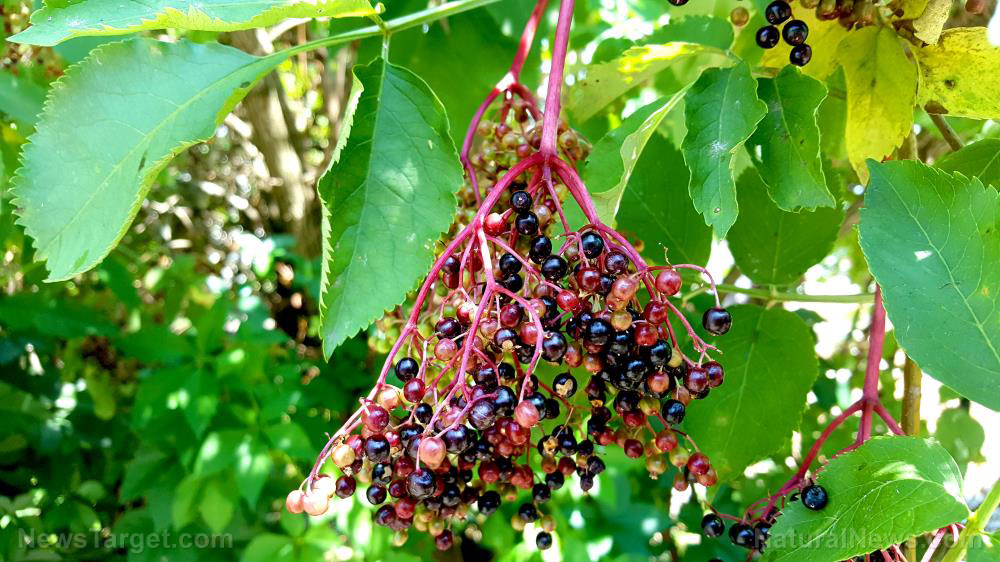The elderberry resurgence: Science validates an ancient remedy for modern immunity
11/24/2025 / By Willow Tohi

- Elderberry’s high concentration of anthocyanins provides potent antimicrobial and antiviral properties, helping to combat influenza and prevent secondary bacterial infections like pneumonia.
- The berry’s rich antioxidant profile, including flavonoids and vitamin C, helps reduce oxidative stress and inflammation, supporting overall immune function.
- Historical use of elderberry dates back millennia, with ancient civilizations and medieval Europeans utilizing it for its versatile healing properties.
- Modern research validates its traditional role, showing it can reduce the severity and duration of upper respiratory infections.
- While effective and widely available, raw elderberries must be cooked before consumption to break down naturally occurring toxic compounds.
As cold and flu seasons grow increasingly unpredictable, a growing number of health-conscious individuals are turning away from solely conventional options and looking to the past for answers. Their focus is elderberry, a dark purple fruit with a history stretching back to prehistoric times, now experiencing a renaissance driven by scientific inquiry. This surge in popularity is not merely a trend; it is supported by emerging research that confirms what ancient healers long asserted: The elderberry is a powerful ally for the immune system, offering a natural, multi-faceted defense against common viral and bacterial threats.
Rooted in history, supported by science
Elderberry’s medicinal pedigree is impressive. The ancient Greeks and Romans harnessed its properties to treat a range of ailments, from inflammation to respiratory infections. Hippocrates himself referred to the elder plant as his “medicine chest” for its versatility. In medieval Europe, it was planted near homes, believed to ward off evil spirits—a folklore that hints at its perceived protective power. Today, the understanding of elderberry has moved from the mystical to the molecular. The berry’s deep hue is a visual clue to its potency, derived from anthocyanins, a type of flavonoid with demonstrated antioxidant, antimicrobial and antiviral effects. This modern validation has propelled elderberry into the mainstream, with its products now constituting a significant segment of the herbal supplement market.
A dual defense against influenza and complications
The threat of influenza is not limited to the virus itself. A significant concern for healthcare providers is the high rate of secondary bacterial infections that can follow a severe flu case. Research indicates that bacterial pneumonia can affect up to 65.7 percent of hospitalized influenza patients. This is where elderberry’s pharmacological profile becomes particularly compelling. The same anthocyanins that give the berry its color have been shown to possess potent antimicrobial properties. This suggests that elderberry supplementation may serve a dual purpose: helping the body fight the initial influenza virus while also providing a preventive barrier against subsequent, and often more dangerous, bacterial infections like pneumonia.
The antioxidant powerhouse within
Beyond its direct action against pathogens, elderberry functions as a robust cellular defender. The berries are loaded with phenolic compounds, including anthocyanins and flavanols like quercetin. These compounds are bioactive, enhancing the antioxidant status of healthy individuals. By neutralizing free radicals and reducing oxidative stress, these antioxidants help protect cells from damage. Furthermore, research has proven that anthocyanins inhibit inflammatory biomarkers, providing a systemic benefit that promotes health and aids in the prevention of multiple viral and bacterial infections. This high antioxidant capacity is a cornerstone of elderberry’s ability to fortify the body’s innate defenses.
From folk syrup to modern mainstay
The most enduring and popular form of elderberry medicine is the syrup. Historically consumed as a tonic, modern homemade versions allow individuals to control the quality of ingredients, opting for organic berries and avoiding unwanted preservatives. The process is simple, typically involving simmering the berries with water and spices, then straining and sweetening the liquid with honey or sugar. This traditional preparation remains a powerful and palatable delivery method. During an active infection, adults may take one to two teaspoons of the syrup several times daily to help reduce the severity and duration of upper respiratory symptoms. For daily prevention, a smaller, maintenance dose can provide ongoing immune support throughout the colder months. A critical safety note echoes through both historical and modern guides: raw elderberries contain cyanogenic glycosides, which can release cyanide and cause illness. Proper cooking neutralizes these compounds, rendering the berries safe for consumption.
An enduring legacy of natural wellness
The story of elderberry is one of continuity. From Neolithic communities and Hippocrates’s medicine chest to the shelves of modern health food stores, this humble berry has maintained its status as a go-to remedy. Today, its legacy is being rewritten not by folklore, but by clinical studies that confirm its anti-inflammatory, antioxidant, antimicrobial and antiviral properties. For college-educated consumers seeking evidence-based natural approaches, elderberry represents a unique convergence of historical wisdom and contemporary science. It stands as a powerful, natural compound offering a layered defense—bolstering the immune system, combating pathogens directly and guarding against serious complications—proving that some of the most effective health solutions are those that have been with us all along.
Sources for this article include:
Submit a correction >>
Tagged Under:
alternative medicine, Antimicrobial, antiviral, Cures, elderberry syrup, food cures, food science, fruits, healing, health science, herbal medicine, Herbs, immune system, influenza, natural cures, natural health, natural medicine, organics, Pneumonia, prevention, remedies, respiratory health
This article may contain statements that reflect the opinion of the author




















